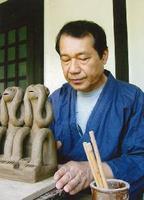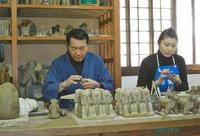

Total:131items
- Pottery & Porcelain (18)
- Lacquerware (4)
- Glasswork (2)
- Wood & Bamboo Work (19)
- Leather Work (1)
- Papermaking (13)
- Textile (20)
- Dyeing products (5)
- Masonry (1)
- Metal Work (11)
- Stationery (4)
- Livingware (3)
- Accessory (4)
- Toys & Entertainment (14)
- Hyuga Goishi: Huga Go Stones
- Kurashiki Hariko: Kurashiki Papier-mache
- Kishu Bina : Kishu Dolls
- Hakata Ningyo: Hakata Doll
- Kaga-mizuhiki: Kaga Paper Cord Ornament
- Kasukabe Oshie Hagoita: Kasukabe's battledore with a padded cloth picture
- Iwatsuki Ningyo: Iwatsuki Doll
- Tsugaru Tako: Tsugaru Kite
- Jindai-Goma: Jindai Spinning Top
- Suruga Hina Dolls
- Knohazaru: Konohazaru Dolls
- Mishima Oni Yōzu kite (Mishima Demon Kite)
- Gunma Kokeshi Doll
- Koga Ningyo: Koga Clay Doll
- Interior (2)
- Other crafts (10)

 |
Main Production Site:Kumamoto |
 《Characteristics》
《Characteristics》The most popular among Konohazaru pottery dolls is the “Three Wise Monkeys (Mizaru, Iwazaru, Kikazaru)” type that embodies the maxim “See no evil, Speak no evil, Hear no evil” (saru or zaru, literally means monkeys).
Besides this type, there are more than ten types of Konohazaru dolls, such as Genshizaru, or primitive monkey dolls that represent wishes for prosperity of descendants and Meshikuizaru, or rice-eating monkey dolls that represent wishes for having enough food for a lifetime. These Konohazaru dolls have been used as charms for warding off bad diseases and misfortunes, prosperity of descendants and so on.
It is believed that the techniques of making Konohazaru dolls have developed from Haniwa (terracotta clay figures) made in the Kofun period (3-7c), or that it has followed the traditional local folk art around the South Sea Islands.
These Konohazaru dolls are the crafts which are shaped using techniques called “tebineri (hand-building)” without molding, and then biscuit-fired. Looking somewhat humorous and simple as well as pure and warm, they delight the eye of the viewers. While preserving traditional crafting method, new products are created up to the present time.
[Traditional Craft designated by Kumamoto Prefecture]
Information provided by Konohazaru Dolls Pottery Studio
Translated by: Chieko Adachi, reviewed by Tomoko Yamamoto

| Materials | Clays and other materials |
|---|---|
| Crafting Processes | 【1】Crushing
Crush clays using crusher to remove gravels and clods of soil and homogenize the clay. 【2】Kneading Put the clay into a kneading machine with water to make the clay easier to knead. 【3】Shaping Place a lump of clay on a small turning plate and shape it into a doll figure by twisting with fingertips. 【4】Drying Dry the figure naturally in the shade for 1-2 weeks. 【5】Biscuit-firing Biscuit-fire the figure at between 800-900 degrees Celsius and then smoke it to add a dark-colored touch. Color it after biscuit-firing when needed. |
| History | The origin of Konohazaru dolls remains unknown even now. There is a legend which has been handed down for a long time.
Four fugitives moved into Konoha village from Kyoto about 1,300 years ago. On some New Year’s Day, an old man appeared in their dreams and told them to build another “Kasuga Daimyo-jin (the Deity in Kasuga shrine in Nara prefecture)” in Konoha village. They followed his message and set up an altar, and made Shinto ritual articles from the red clay of Mt. Konoha. When they finished the work and threw away the rest of clay, it turned into a monkey, bounding away somewhere. They were surprised to see this mysterious happening. At that time, a 3-meter giant with a prominent nose in the red face appeared, said, “You will have a happy life if you make monkey dolls with the clay of Mt. Konoha”, and then disappeared. The four men believed what the giant said to be a message from a god. They made monkey dolls and Shinto ritual articles using the clay and offered them to the god. Thanks to the offering, they survived safely and peacefully even in disasters. Since then, the monkey dolls have been cherished and loved as the charm of warding off illnesses and misfortunes, and for the prosperity of their descendants In the Sengoku (Civil War) period (15-16 c), Sen no Rikyū, who is known as a master of the tea ceremony, had a tea caddy whose pattern looked like a monkey. It was called Konohazaru cha-ire, or Konohazaru tea caddy. Konohazaru dolls became popular all around Japan in the Edo period (17-18c). Located on the way to Edo, present day Tokyo, Konoha village was passed by the party of daimyo, or Japanese feudal lords in Satsuma domain (present-day Kagoshima Prefecture, southern Japan) under Sankin-kotai system (the obligatory relocation imposed by Tokugawa Shogunate, under which daimyos lived in Edo and home alternatively every other year). Konohazaru dolls were preferred souvenirs when they moved to the capital. |
◆Exhibition / Showcase
Konohazaru Dolls Pottery Studio
60 Konoha, Gyokuto Town-machi, Tamana Country-gun, Kumamoto Prefecture,
869-0303 Japan
Open: 8:00 am. - 7:00 pm.
Open all year round
You can experience making traditional Konohazaru dolls.
Fee: \1,500 (Reservation required)
Inquiries: Tel/Fax: +81-(0)968-85-2052 (Japanese only)
◆Event Information
Assistance needed? For inquiries in English:
JTCO Contact Form
Your inquiries will be forwarded by JTCO in Japanese to the organization you wish to contact.
*Please write the name of craft you wish to ask about.



